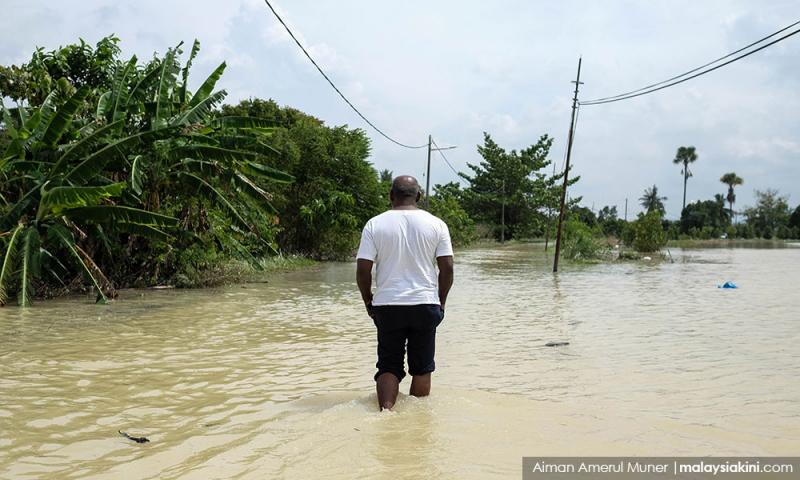LETTER | In 2014-2015, floods displaced more than 200,000 people in more than five states in Malaysia. During the northeast monsoon of 2020-2021, flood cases displaced 42,947, affecting 11,973 families.
The maritime climate of Malaysia makes it particularly vulnerable to extreme precipitation and flooding. With a flood-prone area spanning 29,800km2, affecting approximately 22 percent of the total population, floods remain the most devastating climate-related disaster in the country, and we can expect them to worsen with greater climate change.
The compounded effect of climate impacts and socio-economic inequality will exacerbate poverty and push many households over the edge. Our social safety nets must protect them from falling through the cracks, and our climate policy needs to strengthen the resilience of those most vulnerable to climate impacts. What can be done?
A Malaysian Meteorological Department study reported that in the long term, we will face a wetter summer monsoon season and longer dry spells across all regions. Projections indicate a 20-40 percent increase in extreme weather by the end of the 21st century.
More people are expected to be affected as the intensity and frequency of floods rise. Are our existing structures sufficient to mitigate bigger runoffs? Are our response measures able to minimise damage and our safety nets capable of buffering shocks to the most vulnerable?
Floods aren’t the only risk Malaysia faces, the country also faces a set of climate change impacts that bring about different vulnerabilities, many of which are less spectacular than natural hazards and much more drawn-out than a storm surge.
Unpredictable rainfall due to continuous warming poses significant risks to our water supply, 97 percent of which is drawn from surface water flows and hinges on reservoir storage. Sustained dry spells have the potential of drying up dams leaving relatively populous regions in water stress.
Water risks, on top of heat stress, are particularly perilous to water-intensive sectors such as agriculture and food production, which in turn affect yields and jeopardise food security.
Despite receiving abundant annual rainfall and ranking relatively low on The World Resource Institute’s Aqueduct Water Stress Projections, Malaysia has yet to solve its water problems.
In the case of rising sea levels, Malaysia is endowed with an 8,840km-long shoreline composed mostly of easily eroded alluvium, and with 30.9 percent of its population living in coastal zones, the country has the perfect geophysical circumstances to cook up a perfect storm.
The 2015 National Coastal Erosion Study showed that 15 percent of our total shoreline is already facing erosion.
Coastal zones generally have high intensities of economic activities. In 2009, 17 percent of total employment was in coastal Peninsular Malaysia. Implications of coastline changes range from dislocation, crop failures, land and infrastructural loss, which translates into disrupted livelihoods, leaving coastal residents vulnerable to income shocks.
The wide-ranging effects may be held off by structural barriers and reclamation in the near term, and propitiously Budget 2022 saw a 450 percent increase in allocations to prevent coastal erosion.
However, against alarming rates of sea-level rise projected at 0.44 - 0.74m by 2100, coastal management should equally ramp up their capacities to adapt to more aggressive weathering.
Apart from physical blight, climate change can induce widespread disruptions in socio-economic processes, entailing vulnerabilities in the form of market fluctuations, income irregularities, and cutting off basic entitlements such as food and shelter.
In the absence of means to withstand climate events, poor and marginal communities are disproportionately exposed to climate risks. They face more difficulties in recovering from income and asset loss due to natural hazards, some of them may never recuperate.
These groups are even more vulnerable to direct impact due to climate-sensitive employment, precarious living environments, and exposure to diseases, as well as indirect impact, owing to a lack of resources and support systems.
Impacts of climate change don’t affect communities in isolation. They interact with existing troubles such as poverty, landlessness, occupational and residential immobility.
Without adequate means, the less well-off risk falling over into destitution. Climate vulnerability is multi-layered, our policies need to address the issue justly, and our climate preparedness needs to become genuinely adaptive.
Against the backdrop of continued global warming, the government has made laudable commitments to reduce the greenhouse gases responsible for rising global temperatures.
However, as the recent United Nations (UN) climate science report pointed out, some changes due to emissions are irreversible and already affecting inhabited regions.
Such immediate threats meant that by focusing on emission reduction, we risk distracting ourselves from the inexorable reality that we must learn to live with, and turning aside from those that need help most.
Malaysia’s climate report to the UN identified many physical vulnerabilities and corresponding adaptation measures, with slight mention of social vulnerabilities. The proposed “integrative approach” to disaster risk management in the Twelfth Malaysian Plan touches little upon the social aspects of adaptation.
Having given considerable attention to geophysical, sectoral, and infrastructural vulnerabilities, it is time for the government to shift its approach to recognise the social dimension of climate vulnerabilities, and design corresponding measures to ramp up resilience.
In grappling with the physical impacts of climate change, the government should not lose sight of social and distributional issues, for climate change can be a driver of inequality.
Policy responses should aim beyond simply adapting to future risks but levelling the adaptive capacities of all groups, in order to build a holistic chassis of resilience for Malaysia.
KHOO WEI YANG is a research associate at Khazanah Research Institute.
The views expressed here are those of the author/contributor and do not necessarily represent the views of Malaysiakini.





